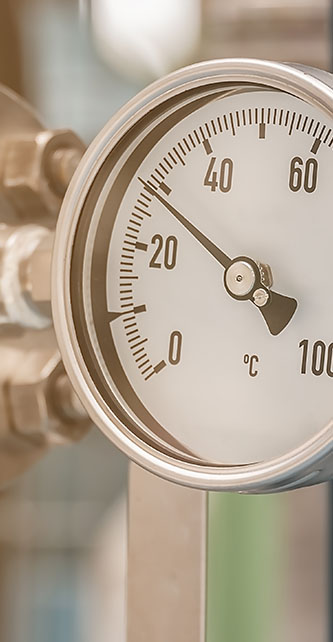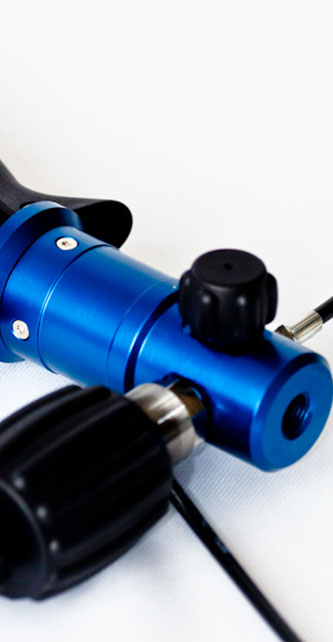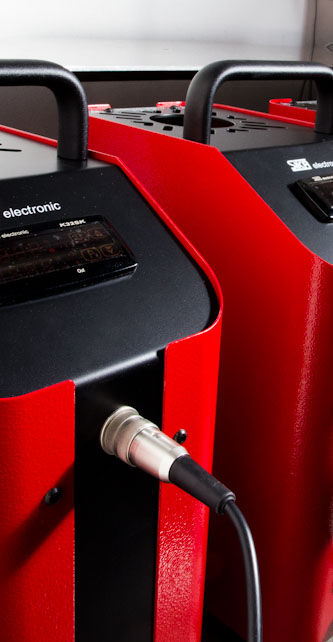Frequently asked questions and background information about SIKA products
Overview

DO YOU HAVE A QUESTION? WE WILL BE PLEASED TO ASSIST YOU!
Scroll down
Overview

Why does the industrial thermometer from SIKA have a V-shaped casing?
Because in this way, the glass insert which is inserted in a recess is protected against mechanical impact without a sophisticated box casing.
Why aren’t there any more high-grade industrial thermometers?
Because from +300 °C, a thermometer filling is required whose boiling point is higher. Blue kerosene-based filling liquid would start to boil.
What is the active length?
In the case of a gas filled dial thermometer, this is the “gas tank” at the tip of the immersion tube. The active length depends on several factors, such as the immersion tube diameter, measuring range, etc.
What is an immersion tube?
That is the part of the thermometer which is “immersed” (screwed or welded) in the process.
What is a protection tube?
This is an additional protection tube which is initially screwed or welded in the process, into which the immersion tube of the measuring device is screwed or inserted.
What is the accuracy class of a thermometer?
It depends on the measuring system. Dial thermometers are divided into classes (error limits depending on the display range) according to DIN EN 13190, the accuracy of glass thermometers is defined in DIN 16195 (not in classes). The deviation depends on the measuring range.
How strong is the influence of the ambient temperature on thermometers?
The influence of the ambient temperature is higher in the case of measuring systems with fillings (gas or liquid), as the effect of the ambient temperature can only be minimised by submerging the majority of the thermometer filling in the process (vessel in the immersion tube contains the majority of the thermometer filling or a bimetal compensation in the case of the gas-filled dial thermometers). Due to their measuring system, bimetal thermometers or temperature sensors aren’t influenced by the ambient temperature so much.
How is l1 measured?
Always including the connection thread, i.e. from below the sealing collar on the hexagon to the end of the immersion tube.
What happens if the liquid in the thermometer breaks up into sections?
In this case, a separation of the thermometric column occurs, which is primarily caused by rough handling during transport or due to improper installation. In minor cases, the sections can be put back together, while serious cases indicate a broken glass insert.
What action should be taken if the column is separated?
There are various ways to put the column back together. For example, you can heat the thermometer very carefully (caution with a naked flame - in the event of overheating, the glass insert will burst!), or you can also shake it like you would a medical thermometer. A detailed guide can be requested from us.
Why must an industrial thermometer not be installed upside down or in horizontal position?
Because this can lead to a separation of the thermometric column.
Why is the casing of some pointer-type measuring instruments filled with a liquid?
The filler material, consisting of silicone oil or glycerine, dampens vibrations and impacts, which can influence the instrument via the process. The pointer movement is also protected against damage, and pointer flutter is reduced.
Why is the casing of the pointer-type measuring instrument not completely filled with silicone oil or glycerine?
So that the filler material is able to expand at different ambient temperatures and the casing does not leak due to overpressure.
When is a protection tube required?
At high temperatures or pressures, when working with aggressive media or high flow velocities and in the case of impurities or foreign bodies in the medium to be measured. Also, if the process is not to be emptied when the measuring instrument is replaced. In these cases, the measuring instrument can be installed in an additional protection tube.
When should multi-part protection tubes be used and when should protection tubes made from solid material be used?
If the protection tube is only designed to seal the process so that the measuring instrument can be changed, a simple multi-part protection tube is sufficient. At higher pressures, protection tubes made from solid material are more appropriate.
What material should the protection tube be made from?
This depends on the medium and the material in the pipeline. In the case of protection tubes designed for welding, the material of the protection tube and the pipeline should match.
Are industrial thermometers with a brass immersion tube suitable for potable water?
Our industrial thermometers do not have any explicit certification. We can confirm, however, that we only use brass that is suitable for drinking water (e.g. CW617N-DW) when manufacturing immersion tubes and protection tubes that come into contact with media.

Can all the hydraulic hand-operated pumps from SIKA be operated with water?
Yes, that is one of the main advantages of the P700.3 and P1000.2, as water is much easier to handle than hydraulic oil.
Can the pneumatic P40.2 hand-operated pump also be operated in the vacuum range?
Yes, because it has a pressure-vacuum switch.
Is the P4 also to be used for small differential pressures?
Yes, with the T-adapter, which is included in the scope of delivery, including a pneumatic hose.
Is the P4 also in the vacuum range?
No, unfortunately not; there is no pressure-vacuum shuttle valve. Low pressure can only be generated to a limited extent with the use of a fine-setting valve.
Is the pressure hose for the P1000.2 safe to operate?
Yes, according to the Pressure Equipment Directive (1.5 times the nominal pressure), each hose is individually tested at 1,500 bars.
What does the maximum negative pressure to be generated depend on?
The decisive factor is the volume that has to be “emptied”. With small volumes, the P40.2 can also reach -0.98 bar. An absolute vacuum (-1 bar) is, of course, not attainable.
With the P4, does the pressure depend on the temperature?
In principle, the pressure always depends on the temperature, if the pressure body is hermetically sealed. The P4 has plastic surfaces for insulation, so that the heating is compensated for by the handling.
As a customer, can I obtain customised adapters from SIKA?
Yes, everything is possible, although individual designs require time and money.

Why do I require a linearisation?
To ensure that the calibrator has an accuracy which is detectable and traceable according to national standards, it is necessary to linearise it according to these standards during its manufacture.
Many models of calibrator only allow for one calibration function (e.g. dry block with internal reference sensor). For the models on which several calibration functions are possible, it is necessary for all of these to be linearised on an individual basis. As the linearisations are very precise and time-consuming, approximately 1 working day per linearisation can be expected. In the case of multifunction calibrators, more than 20 different linearisations are theoretically possible. To ensure that the costs and delivery time do not increase as a result of the linearisations, the required calibration functions (linearisations) should be chosen by the customer when they place their order. This also results in lower follow-up costs during the re-calibration, as the calibrator is only given the calibration functions that are actually required.
Is it possible to retrofit the TP Basic or TP Solid with an external reference sensor?
In the case of the temperature calibrators in the TP series, the external reference sensor is one of the components that leads to the best calibration results. With calibrators in the TP Basic and TP Solid series, the external reference sensor is not required – in the case of TP Basic and TP Solid, the required accuracy is achieved without the external reference sensor.
Is a LabVIEW connection possible?
We will provide you with our corresponding communication commands for your individual LabVIEW connection.